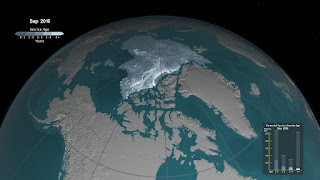We now have to wonder if we have reached a turning point with regard to sea ice. What I mean is that we can no longer simply conclude the sea extent is decreasing, we have to wonder if it hasn't collapsed. Take a look at these graphics from NASA, one from 1984 and the other from 2016.
 |
| Source: NASA |
 |
| Source: NASA |
But, there is another problem. The amount of open water increases the chances of the ice being broken up by waves. Waves hitting the ice will tend to break it up and broken ice will melt faster than sold ice due to the increased surface area (crushed ice in your drink melts more quickly than the same amount of ice as cubes). Waves are getting worse due to the increased open sea, so more ice is being broken up.
Fetch is the term describing how long a wave has to build. The longer the fetch, the more likely the wave will be larger. That's why ocean waves are larger than waves on a lake and waves on a lake are larger than waves on a pond. The larger the fetch, the larger the wave. As the ice extent gets smaller, the fetch in the Arctic Ocean gets bigger, meaning the typical wave, especially in a storm, will be bigger. Here is a nice article discussing this issue.
So, ice extent is getting smaller, ice thickness is getting thinner, waves are getting larger. Can anything else go wrong? Yes, as a matter of fact. Take a look at the air and sea water temperature anomalies.
 |
| Source: Climate Change Institute |
 |
| Source: Climate Change Institute |
The air temperature is more than 20 degrees F warmer than normal and the sea water temperature is about 4 degrees F warmer than normal. It become much harder to make ice when the air and water are warmer.
Take another look here:
 | |
| Arctic Temperature 2016 - Danish Meteorological Institute |
 |
| Arctic Temperature 2017 - Danish Meteorological Institute |
But, the real question is, why is it so warm? Because there is more open water, which absorbs sunlight and gets warmer during the sunlit months instead of reflecting it. So, as the ice extent recedes, the very thing that caused it to recede in the first place gets worse, causing an even greater amount of recession in future years, which allows an even greater amount of sunlight absorption. At some point, the amount of open water will cause a complete breakdown of the sea ice.
Are we at the breakdown point, yet? I think so. We'll see ice in the winter simply because the Arctic has long nights in the winter months and it will still get cold. That's due to the tilt of the Earth's axis and climate change will not affect that. But, those nights, while still deadly cold, won't be as cold as they were before, meaning we won't see as much sea ice. Here is today's ice extent. The light blue line shows the long-term average for comparison purposes.
 |
| Source: Climate Change Institute |
The sea ice extent has been trending much more than two-standard deviations below the long-term average and is setting new records for the least amount of extent ever measured for this time of year. The below graph is from the National Snow and Ice Data Center and shows the ice extent as a function of day of the year. The solid line towards the top is the long term average. The dotted line is the ice extent for 2012, the year with the record low minimum extent. The purple line is for 2006, the previous low year for this time of year. The unfinished, light blue line is for 2017. The shaded areas show one- and two-standard deviations from the long-term average.
| Source: NSIDC |
Based on this data, I'm going to forecast that the sea ice maximum extent will occur in the first week of March and will be about 14.2 million square kilometers. That would make it the lowest maximum extent ever recorded. I'll also go out on a limb here and give my forecast that 2017 will set the record for the lowest minimum extent in September.
In case you were wondering, things are not much better in Antarctica.
| Source: NSIDC |
But, we aren't done. Take a look at this graph of Greenland's mass balance.
 |
| Source: Polar Portal |
 |
| Source: Polar Portal |
The general consensus is that the Arctic will routinely experience ice-free summers some time around 2050. That may be so, but I'm willing to predict we will see the first ice-free Arctic summer within the next ten years. It won't stick, but the first one is coming much sooner than we want to believe.
But, even with the mountain of scientific data available to anyone with an Internet connection, the science deniers are still claiming the ice extent is not going down. Truly amazing. By the way, don't read that article unless you want to know how much disinformation can be crammed into one article. But, if you scroll down a few paragraphs, the author makes the claim the state of the sea ice is just fine. Clearly, science and reality don't have any affect on him. Oh, and someone should tell him 2-meter ice isn't old ice, it's new. Old ice is at least 4 meters thick. You can reach any conclusion you want when you don't care about the facts.
No comments:
Post a Comment